Rava Dhokla (Sooji Dhokla)
Rava Dhokla are steamed savory cakes made with semolina and topped with a tempering of curry leaves, mustard seeds, cilantro! This instant version of Rava Dhokla results in perfectly soft and fluffy dhokla which is great for breakfast or snack!
This post may contain affiliate links. Please read our disclosure policy.
This homemade recipe of rava dhokla is made with simple ingredients and results in a soft and fluffy instant rava dhokla. This is an eggless savory cake made with semolina and is great for breakfast or snack!
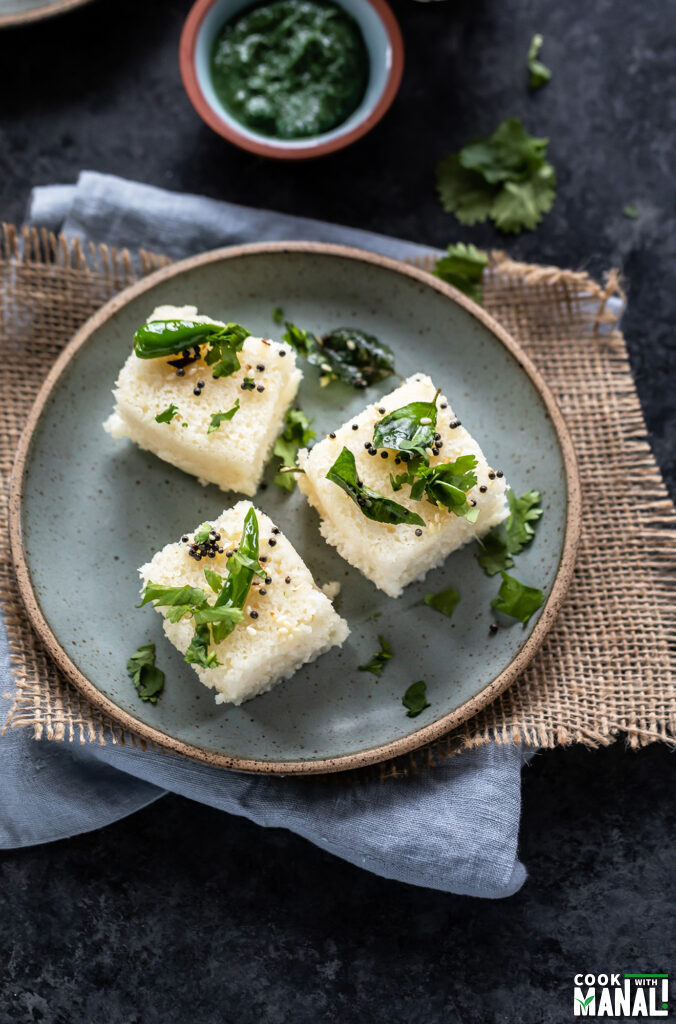
Dhokla is one of my absolute favorite things to eat for breakfast or snack. Growing up, I mostly knew about instant dhokla made with besan- the yellow one. It was later in life when I learnt about different foods that I came to know that besan dhokla is actually called khaman and white dhokla is made from rice and dal batter!
India is so diverse when it comes to food that people living in neighboring states would also not know about each other’s food. I grew up in north India and so dhokla which is a western India specialty wasn’t something that was made in my house. That’s why I always find it so amusing when Indian food is generalized in the western world as “curry” and “naan”.
Anyway now that I am aware of the different types of dhokla and how they are made, I do make them often for snacks. One dhokla which I make and love for snacking is Rava Dhokla or Sooji Dhokla whatever you want to call it.
It’s made with semolina aka rava/sooji as the name suggests and makes a nice light snack or breakfast. You can steam these in a stove-top steamer or you can also use your Instant pot for it.
What is Dhokla Anyway?
For my readers who aren’t from India and are confused as to what dhokla is. Think of it as a steamed savory cake. It can be made with besan (chickpea flour), rice and lentils, sooji (semolina) and more.
The traditional way to make it is by fermenting the batter and then steaming it (like the idli dosa batter). The instant versions depend on things like baking soda or ENO (fruit salt) to give the batter an instant rise before steaming. I definitely make the instant versions all the time.
These are usually flavored with ginger, chilies and tempered with mustard seeds, sesame seeds, curry leaves, cilantro, coconut etc.
This rava dhokla is made with semolina, some people also call it white dhokla though traditionally white dhokla is used for the dhokla made with rice and dal fermented batter.
Ingredients
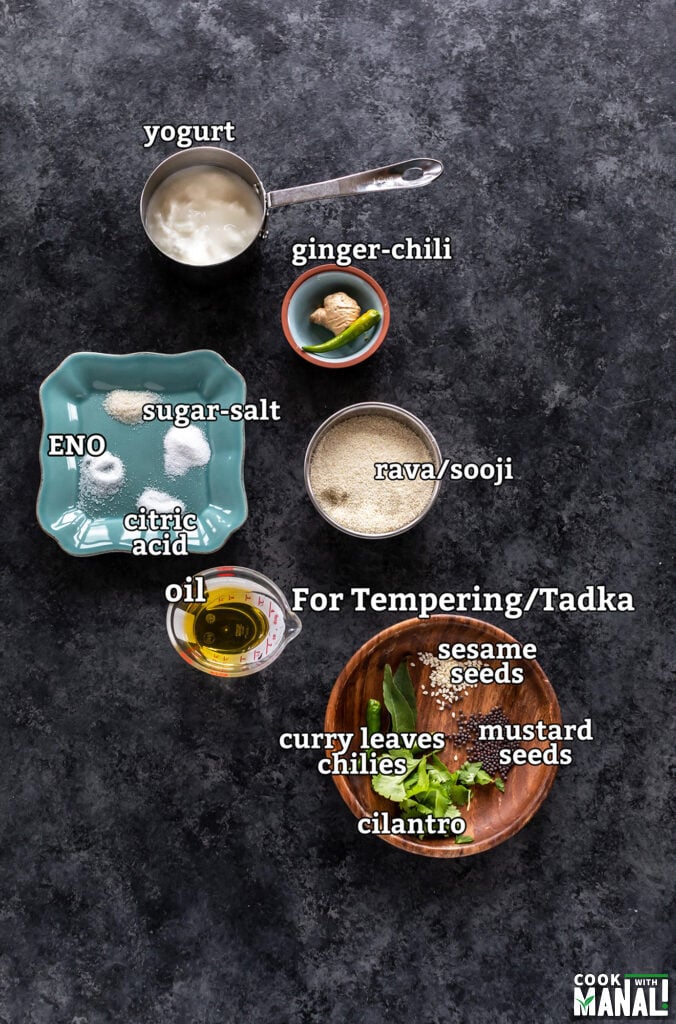
Semolina (Rava/Sooji): for this dhokla recipe, I have used regular coarse sooji that I use to make upma. You can definitely make this recipe with fine sooji as well and the texture will be lighter but coarse works just fine.
Yogurt: this instant version depends on yogurt to give dhokla that “sourness”. I used thick yogurt which was store bought.
Flavorings: ginger, green chilies, salt and sugar are used to flavor the dhokla batter. You can adjust the amount of chilies to taste. You may also skip the sugar but I feel it helps balance out the flavors.
ENO: fruit salt or ENO is commonly used to aerate the batter before steaming it. ENO makes the dhokla fluffy, spongy and gives it a rise. You can find it at any Indian grocery store and you need the plain unflavored one for this.
Ingredients Substitutions: you can replace ENO with 1/2 teaspoon baking soda however in my experience the dhokla turns out better with ENO. Also if you don’t have citric acid, replace it with 1/2 tablespoon lime juice however I do recommend using citric acid if possible.
Step by Step Instructions
1- To a large bowl, add 1 cup rava/sooji along with 1 cup yogurt.
2- Then add the following:
- 1 teaspoon minced ginger
- 1-2 minced green chilies
- 3/4 teaspoon salt
- 1/2 teaspoon sugar
- 1/4 teaspoon citric acid
3- Add in 2 teaspoons oil (I used avocado oil).
4- Add water, around 1/4 cup.
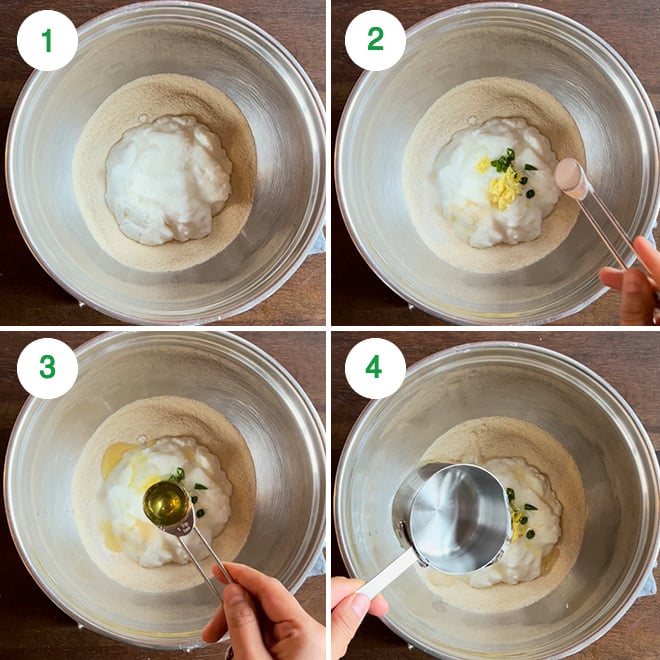
5- Mix well until it’s all well combined using a whisk.
6- Cover the bowl with a plate and let it sit for 20 minutes. Meanwhile grease the pan in which you are going to steam the dhokla with oil and set aside. Also, keep your steamer ready, I boil 2 cups of water on medium heat in my steamer.
7- After 20 minutes, rava would have soaked all the water. Now add additional water (around 1/2 cup, so total water added is 3/4 cup) and mix.
8- Add 1 teaspoon ENO (fruit salt).
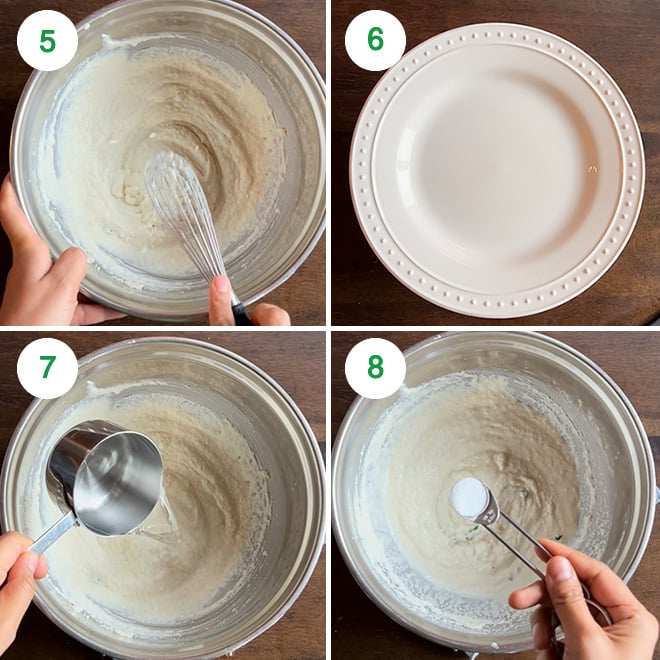
9- Using a spatula, mix gently until all the ENO is well incorporated into the mixture. You will notice the mixture will turn light and airy immediately. Don’t overmix at this point. You have to do all steps quickly at this point.
10- Immediately, transfer the batter into the greased pan.
11- Place the pan immediately into the steamer.
12- Cover the steamer with it’s lid and steam for 15 to 20 minutes on medium heat.
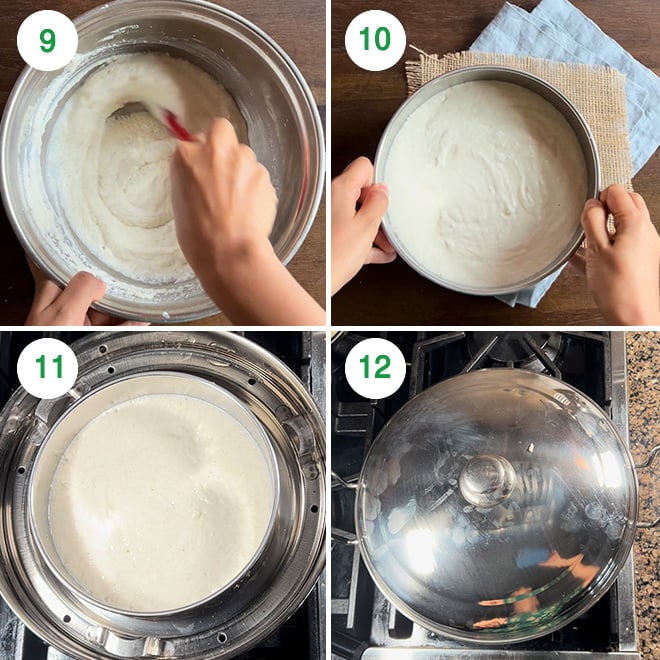
13- While the dhokla is steaming, make the tadka. To a small pan, add 1 tablespoon oil on medium heat. Once the oil is hot, add 1 teaspoon mustard seeds and let them pop.
14- Then add the following:
- 1 teaspoon sesame seeds
- 10 curry leaves
- 2 green chilies, sliced
Give a quick stir, you don’t want to brown the sesame seeds. Remove pan from heat and add around 2 tablespoons water and stir.
15- To check if dhokla is steamed, insert a knife in the center, it should come out mostly clean without batter sticking to it. Remove the pan from steamer. Let it sit for 5 minutes, then invert the dhokla onto serving plate by placing a plate on top on the dhokla pan and then turning it upside down. It should come off easily if you greased the pan well. You can pour the tempering directly without inverting the dhokla as well but the tadka seeps in better from the sides when you invert the dhokla on a plate.
16- Pour prepared tempering all over the dhokla. Cut into pieces and serve!
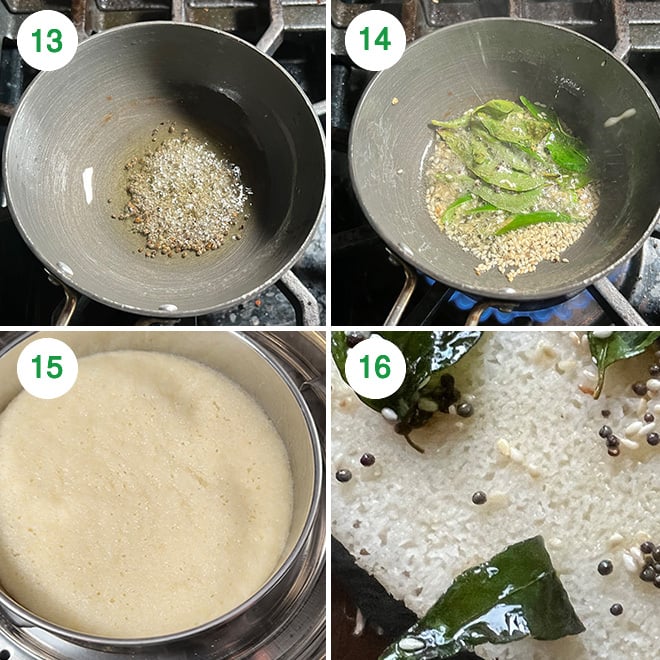
Instant Pot Version
I have made this recipe in Instant Pot and it works fine. However, I do like the stove-top version more.
If you want to steam rava dhokla in the instant pot, add 2 cup water to the inner steel pot of your Instant pot. Press sauté and let it come to simmer. Place trivet inside the pot and then place your dhokla pan on top of the trivet. Cover it with a lid.
Press steam button and timer to 15 minutes with the pressure valve in venting position. Since the time doesn’t work in venting position, you will have to use an external timer.
Serving Suggestions
Rava dhokla can be served as such with a cup of chai. You can also serve it with cilantro chutney or sweet tamarind chutney.
One of the things I like about dhokla is that it’s served at room temperature making it the perfect snack to make in advance. It’s great to make for parties for this very reason.
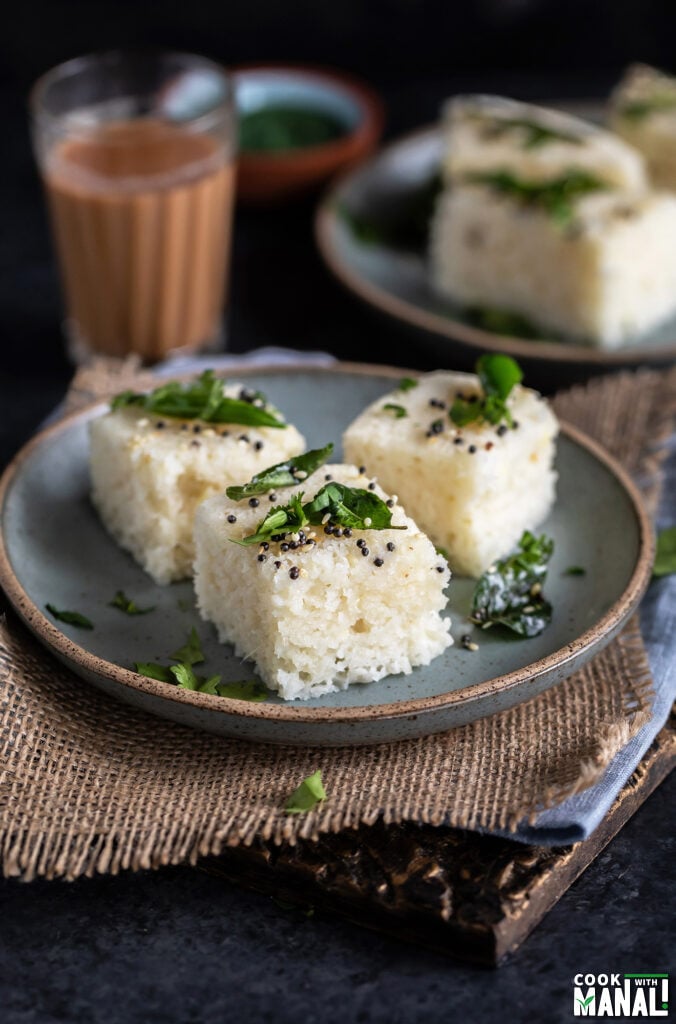
Tips & Notes
- Once you mix in the ENO, you have to immediately steam the batter. Do not wait else dhoklas won’t turn our spongy. So, make sure you have the steamer ready to go when you add in the ENO.
- Adding water to the tadka makes the dhokla softer so do not skip on it.
- You can replace ENO with baking soda but I prefer and recommend using ENO, it gives better results.
- Same with citric acid, you can replace with lime juice but I prefer citric acid in this recipe.
- I have used coarse sooji to make this dhokla, using fine sooji will result in a lighter texture but coarse works just fine as well.
If you’ve tried this Recipe then don’t forget to rate the recipe! You can also follow me on Facebook, Instagram to see what’s latest in my kitchen and on YouTube to watch my latest videos.
Rava Dhokla
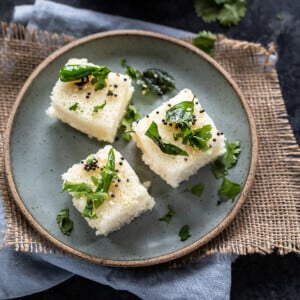
Ingredients
- 1 cup sooji/rava 180 grams, semolina
- 1 cup yogurt 240 grams, plain whole milk yogurt
- 1 teaspoon ginger minced
- 1-2 green chilies minced
- 3/4 teaspoon salt
- 1/2 teaspoon sugar
- 1/4 teaspoon citric acid or use 1/2 tablespoon lime juice
- 2 teaspoons oil I used avocado oil
- water around 3/4 cups, may vary depending on the quality of the rava being used
- 1 teaspoon ENO
Tadka
- 1 tablespoon oil
- 1 teaspoon mustard seeds
- 1 teaspoon sesame seeds
- 10 curry leaves
- 2 green chilies sliced
- 2 tablespoons water
- cilantro chopped
Instructions
- To a large bowl, add 1 cup rava/sooji along with 1 cup yogurt.
- Then add in minced ginger, minced green chilies, salt, sugar and citric acid. Also add the oil.
- Add water, around 1/4 cup and mix well until it's all well combined using a whisk.
- Cover the bowl with a plate and let it sit for 20 minutes. Meanwhile grease the pan in which you are going to steam the dhokla with oil and set aside. Also, keep your steamer ready, I boil 2 cups of water on medium heat in my steamer.
- After 20 minutes, rava would have soaked all the water. Now add additional water (around 1/2 cup, so total water added is 3/4 cup) and mix. You want a consistency like idli dosa batter consistency. The amount of water may vary depending on the quality of rava being used.
- Now add in the ENO. Using a spatula, mix gently until all the ENO is well incorporated into the mixture. You will notice the mixture will turn light and airy immediately. Don't overmix at this point. You have to do all steps quickly at this point.
- Immediately, transfer the batter into the greased pan. Place the pan immediately into the steamer. Cover the steamer with it's lid and steam for 15 to 20 minutes on medium heat.
- While the dhokla is steaming, make the tadka. To a small pan, add 1 tablespoon oil on medium heat. Once the oil is hot, mustard seeds and let them pop.
- Then add the sesame seeds, curry leaves, sliced green chilies. Give a quick stir, you don't want to brown the sesame seeds. Remove pan from heat and add around 2 tablespoons water and stir.
- To check if dhokla is steamed, insert a knife in the center, it should come out mostly clean without batter sticking to it. Remove the pan from steamer. Let it sit for 5 minutes, then invert the dhokla onto serving plate by placing a plate on top on the dhokla pan and then turning it upside down. It should come off easily if you greased the pan well. You can pour the tempering directly without inverting the dhokla as well but the tadka seeps in better from the sides when you invert the dhokla on a plate.
- Pour prepared tempering all over the dhokla. Cut into pieces and serve!
Notes
- Once you mix in the ENO, you have to immediately steam the batter. Do not wait else dhoklas won’t turn our spongy. So, make sure you have the steamer ready to go when you add in the ENO.
- Adding water to the tadka makes the dhokla softer so do not skip on it.
- You can replace ENO with baking soda but I prefer and recommend using ENO, it gives better results.
- I have used coarse sooji to make this dhokla, using fine sooji will result in a lighter texture but coarse works just fine as well.
Nutrition
Nutrition information is automatically calculated, so should only be used as an approximation.
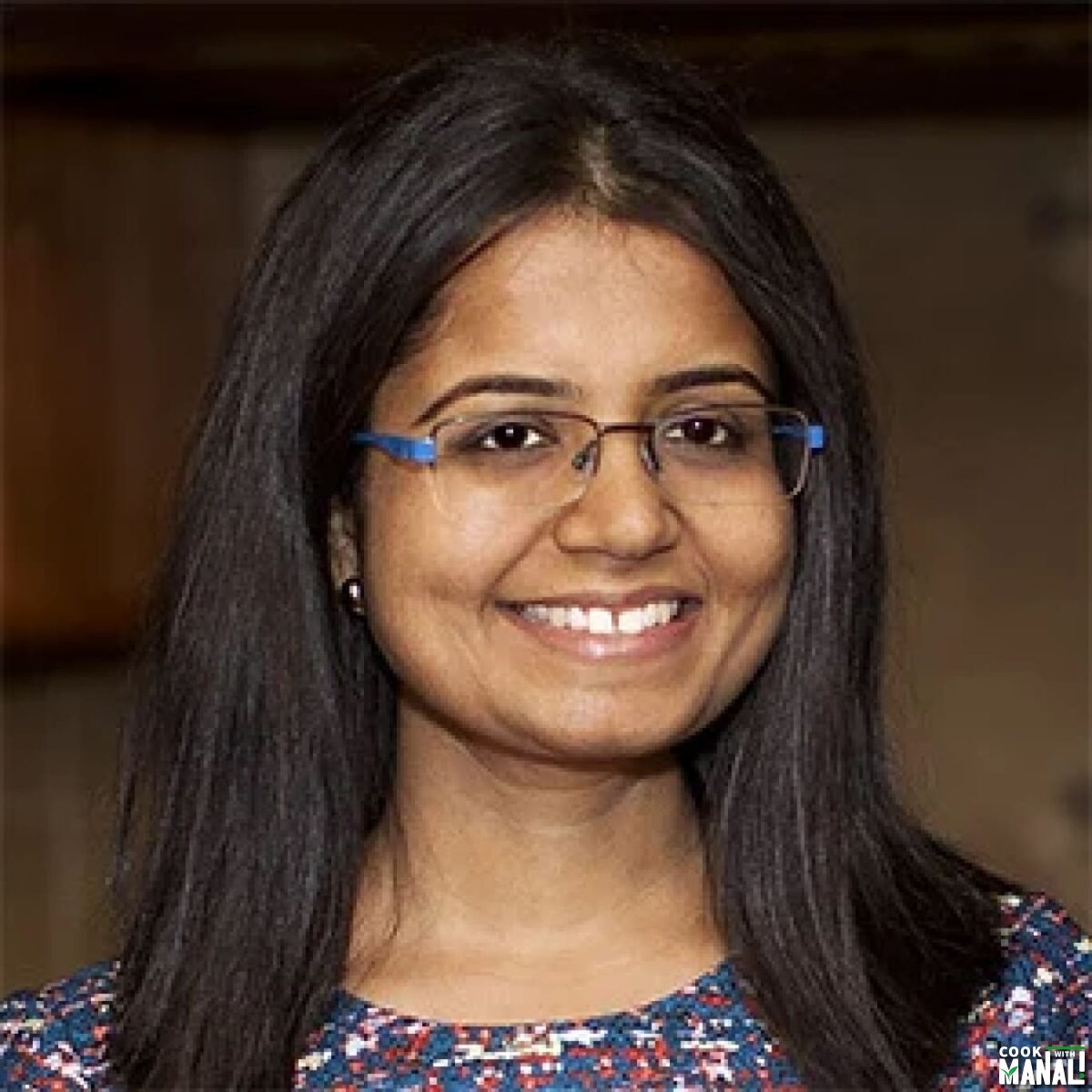
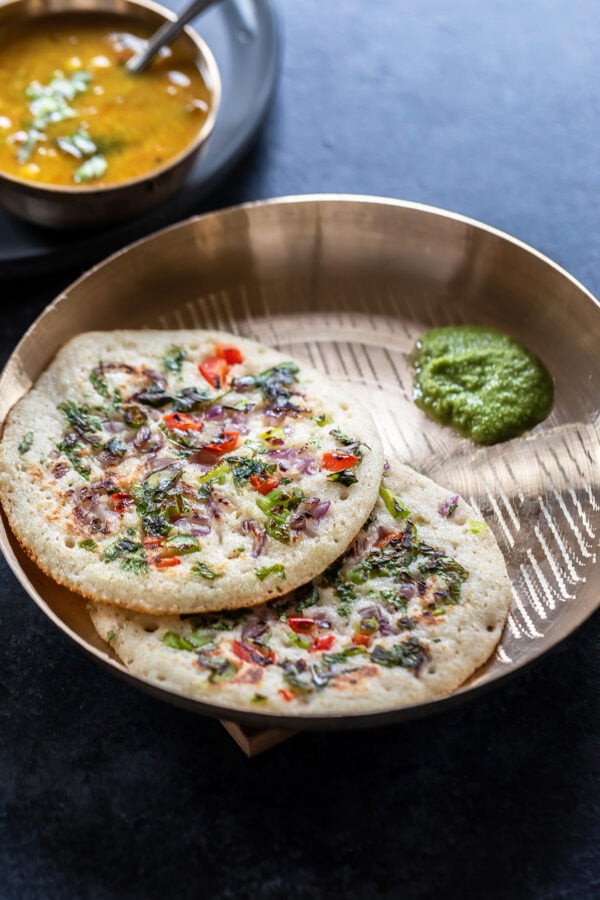
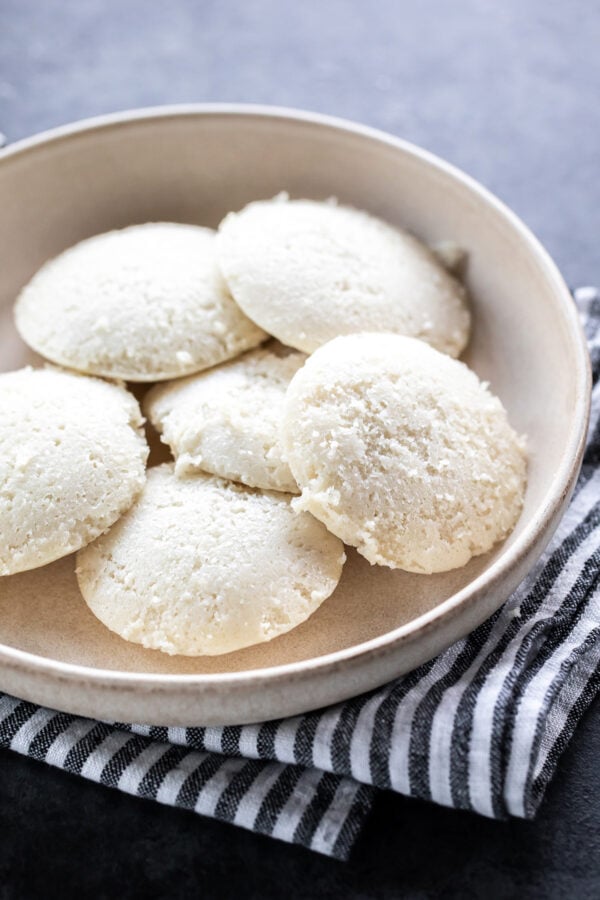
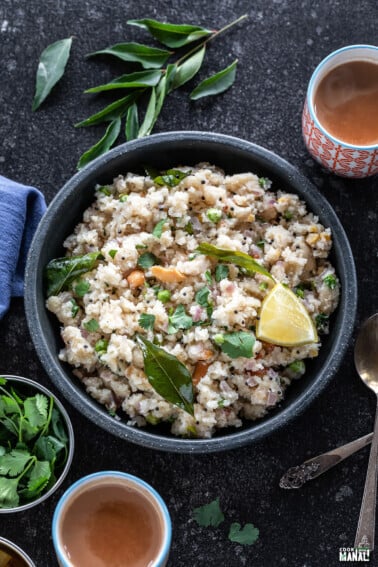
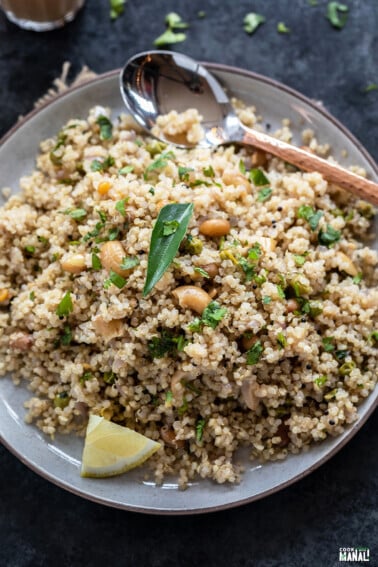









Nice recipe. Came out very well. Thanks.
glad to know!